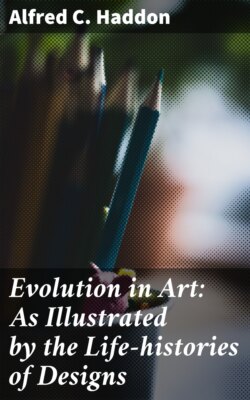Читать книгу Evolution in Art: As Illustrated by the Life-histories of Designs - Alfred C. Haddon - Страница 16
На сайте Литреса книга снята с продажи.
V. Treble row of faces.
ОглавлениеThis is a composite series which is composed of Series II. and III. It resolves itself into two main groups, the second of which, so far as I am aware, is represented by only a single specimen.
(I.) Vertical faces looking towards one another.—Owing to the variety of their component elements the patterns in this series of belts are liable to considerable variation, but there is no need to enter into an analysis of the possible modifications.
In Fig. 17 we have an example of the preponderance of the horizontal faces, while some of the vertical faces are extremely degraded.
Fig. 17.—Maiva, Berlin Museum.
Fig. 18 represents a condition in which the vertical faces are monocular; the line beneath the eye is evidently the suggestion of a nose, and the angled dentate line indicates the mouth with its teeth. All these faces are equally developed. The horizontal series of faces belong to Series II., 2, b, as the faces looking towards one another are grouped together. In the centre of each space between a pair of vertical faces is a mouth which has to do duty for two horizontal faces; on each side of this is a horizontal line which is a vestigial nose, the arrow-head figure on which indicates the nostrils. The eye between the mouths of the vertical faces represents two pairs of eyes of the horizontal series.
(II.) Vertical faces looking away from one another.—The only belt with which I am acquainted which probably belongs to this subdivision of the series is that reproduced in Fig. 19. The design is more regular and sustained than is usually the case on these belts. The vertical series of faces is represented by a median series of fused mouths and eyes; the chevron band indicates the nose, on which nostrils may be located close to the mouth or close to the eye. The eyes of the vertical series of faces are enclosed within confluent eye-areas; the median nose-line runs to the border pattern of the belt, but there is no trace of a mouth. The border pattern is, I believe, unique on belts.
Fig. 18.—Edinburgh Museum.
The bamboo tobacco-pipes are ornamented by scraping away some of the rind of the bamboo and colouring the intaglio portions with brown pigment; in these also the designs are based on human faces and their derivatives; sometimes the human form is employed, and occasionally zoomorphs are depicted.
It would be tedious to describe all the objects which are decorated by these artistic people; enough examples have been given to illustrate the style of their art. We cannot at present say why anthropomorphs should predominate in so marked a degree. I suspect it has something to do with the importance of initiation ceremonies combined with the ancestor cult, which is a marked feature of the true Papuans. I would also hazard the conjecture that animal totemism is not of such prominence amongst these people as it was recently in Torres Straits, and still is on the neighbouring coast of New Guinea and in Australia.
Fig. 19.—Museum of the London Missionary Society.
